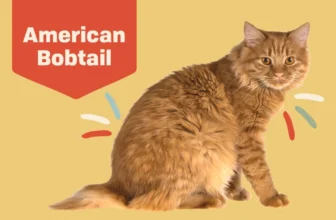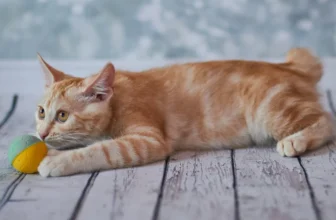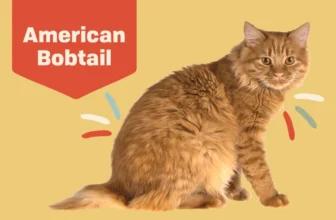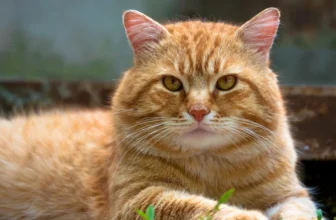As humans, we’ve always been fascinated by the variety of animal species that exist. One of the most interesting aspects of animals is the physical characteristics they possess, which have evolved over time. The American Bobtail is a breed that has been around for many years, with their unique tails being the center of attention. This article will explore not only the history of the American Bobtail tail but also its characteristics, changes in the breed standard, and what the future holds for this distinctive breed. Get ready to dive deep into the evolution of the American Bobtail’s tail!
The Origins of the American Bobtail Tail
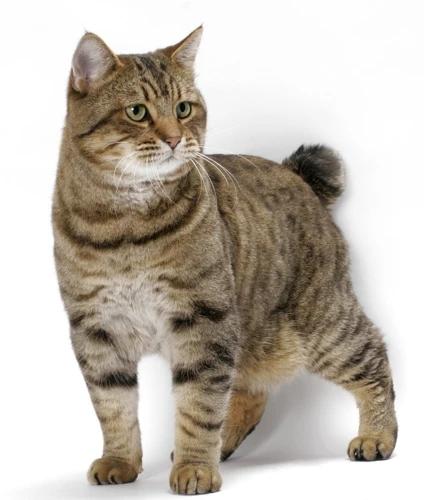
As one of the most distinctive features of the American Bobtail breed, the tail has long puzzled scientists and breeders alike. There are numerous theories and speculations surrounding the origins of the American Bobtail tail, with little consensus among experts. However, by examining historical evidence and the characteristics of the tail itself, we can gain insight into this unique aspect of the breed. In this section, we’ll explore the possible origins of the American Bobtail tail and what makes it so different from other feline tails. To learn more about other aspects of the American Bobtail tail, such as length, shape, and care, check out our dedicated articles on tail length, tail shapes and meanings, tail muscles and agility, tail size and balance, and tail care.
Theories and Speculations
One of the most popular theories about the origin of the American Bobtail tail is that it is a result of a genetic mutation. This mutation was speculated to have occurred naturally and randomly in the domestic cat population in the United States. The mutation could have first appeared as a result of a spontaneous genetic change or due to interbreeding with wild bobcats. However, there is no clear evidence to support either of these claims.
Another speculation is that the American Bobtail tail is the result of selective breeding. Breeders may have intentionally crossbred domestic cats with bobcats to create the unique appearance of the American Bobtail, including the distinctive short tail. Some breeders also claim that the Manx cat, which is known for its lack of tail, was used in the breeding process of the American Bobtail. However, this theory has not been proven either.
It is also possible that the American Bobtail tail is the result of a combination of genetic mutations and selective breeding. Regardless of how the breed came to have its unique tail, it has become an integral part of its identity.
Although further research is needed to fully understand the origins of the American Bobtail tail, it is clear that this breed is unique and highly valued by cat lovers. The genetic mutation that is responsible for the breed’s distinctive appearance has been studied by scientists over the years, and it is believed to be a dominant gene. This means that it can be passed down to future generations, which has allowed the breed to thrive.
It is interesting to note that the bobtail gene is not exclusive to the American Bobtail breed. In fact, it has been observed in other cat breeds, such as the Japanese Bobtail and the Kurilian Bobtail. However, it is the American Bobtail that has become the most popular and recognizable breed with a short tail.
The origins of the American Bobtail tail remain a mystery. However, what is clear is that this breed has a unique and fascinating history that has captured the hearts of many cat enthusiasts.
Historical Evidence
There is a limited amount of historical evidence on the American Bobtail tail’s evolution, but experts have made several compelling theories. One such theory is that the bobtail gene was introduced to American cats by Asian immigrants. This theory is supported by the fact that bobtailed cats have been spotted in Japan and other parts of Asia for centuries. Another theory suggests that the bobtail gene is a mutation that originated in North America.
Historical Evidence
| Theory | Evidence |
|---|---|
| Asian Immigration | Bobtailed cats spotted in Asia for centuries; some Asian immigrants brought pets to America |
| Mutation | Bobtail gene may have spontaneously occurred in North America; genetic testing supports this theory |
Scientific research has also contributed valuable insights into the American Bobtail tail’s evolution. A study published in the Journal of Heredity suggests that the bobtail gene is dominant, meaning it is more likely to be passed down to offspring. This study also found evidence that the gene is related to the Manx gene, which is responsible for the Manx cat’s lack of tail.
While there is no definitive answer on the American Bobtail tail’s origins, numerous theories and scientific studies have shed light on how this unique breed came to be. To learn more about the bobtail gene and its relationship to American Bobtails, check out our article on the bobtail gene and American Bobtails.
The American Bobtail Tail’s Characteristics
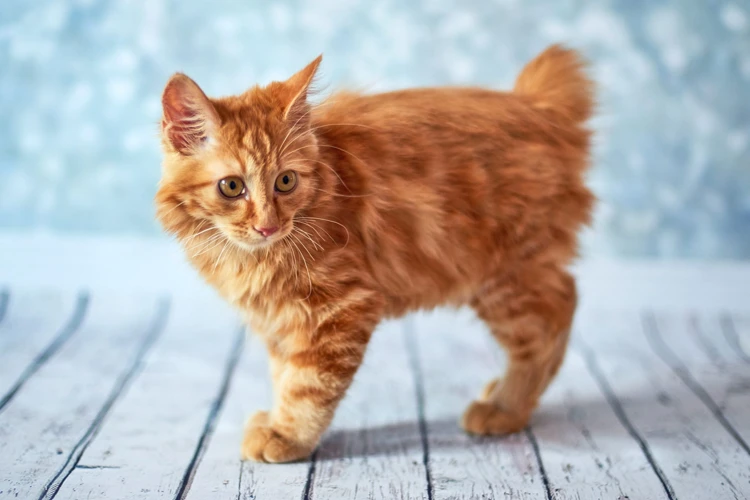
The American Bobtail’s tail is one of the most unique features of the breed. This feline’s tail is different from most others and boasts several distinctive characteristics that set it apart. In this section, we will explore the length, shape, color, and texture of the American Bobtail tail. Understanding these features is crucial in comprehending the breed as a whole and appreciating the beauty of these magnificent cats. Let’s delve right in!
Length and Shape
The American Bobtail is a unique breed that is identified by its short tail. The length and shape of its tail have undergone a significant evolution over time. Initially, the American Bobtail tail could have been as short as two to three inches, which is much shorter than the average cat tail. However, modern-day American Bobtails are known for their tails, which are usually between one-third to half the length of an average cat’s tail.
In addition to its length, the shape of the American Bobtail tail has also changed over time. The early American Bobtail breed had tails that were often kinked or curved, which gave the tail a unique and distinctive appearance. However, modern American Bobtails are bred to have tails that are more naturally curved and may have a slight bump, but not a full kink or curve.
To better understand the changes in the length and shape of the American Bobtail tail, let’s explore its historical development in more detail.
| Time Period | Length | Shape |
|---|---|---|
| Origins of the breed | Two to three inches | Kinked or curved |
| Early 2000s | One-third to half the length of an average cat’s tail | Slightly curved |
| Modern-day | One-third to half the length of an average cat’s tail | Naturally curved with a slight bump |
It’s clear from the table that the American Bobtail tail has evolved over time. Today’s American Bobtail is bred to have a tail that is proportional to the length of the body, and the tail’s shape is meant to enhance the breed’s muscular and athletic build. Despite these changes, the American Bobtail is still recognized for its unique and adorable tail, which is considered to be one of the breed’s most distinctive features.
Color and Texture
The color and texture of the American Bobtail tail is a defining characteristic of the breed. Generally, the tail should be medium to long in length, and covered in a thick, lush coat of fur. The texture of the fur should be “shaggy,” with longer guard hairs and a soft undercoat.
Regarding color, American Bobtail tails can vary widely. According to the breed standard, any color or pattern is acceptable, including the popular tabby, solid black or white, and tortoiseshell varieties. One interesting aspect of the breed is the presence of a “bottlebrush” tail, which is a tail that appears thick and fluffy, similar to a bottle brush. Bottlebrush tails can be found in a variety of colors and patterns as well.
To provide more detail, we’ve compiled a table below summarizing the various colors and patterns that are commonly seen in American Bobtail tails.
| Color/Pattern | Description |
|---|---|
| Tabby | Vertical stripes or swirls of dark markings on a lighter background |
| Solid | A uniform color, ranging from black to white and everything in between |
| Tortoiseshell | Blotches of black, orange, and/or cream, often in a “tortoise shell” pattern |
| Calico | White with larger patches of black and orange, often with distinct boundaries between the colors |
| Bicolor | White with patches of black, orange, or another color in any combination |
| Tricolor | White with patches of black and orange, often with additional patches of cream |
| Bottlebrush | A thick, fluffy tail with a variety of colors and patterns |
It’s worth noting that some breeders prefer a certain color or pattern over others, and may specialize in breeding American Bobtail tails of that variety. However, great care should be taken to ensure that breeders do not prioritize appearance over health and temperament when selecting breeding pairs.
The Modern American Bobtail Tail
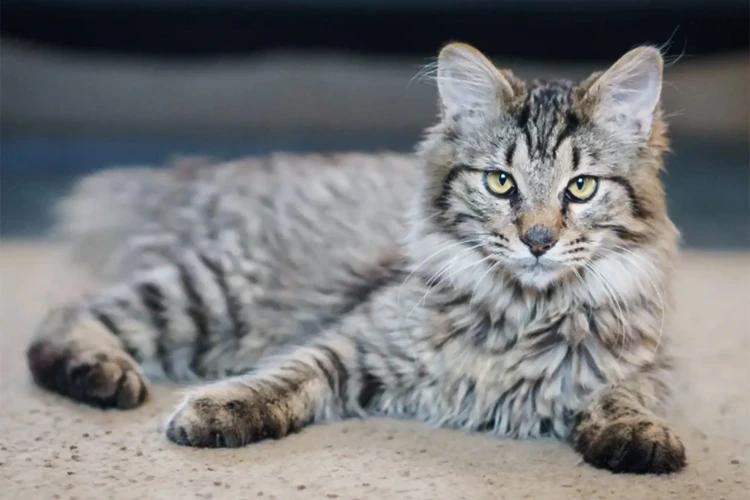
As the American Bobtail cat breed grew in popularity, breeders began to focus on creating a standard for what the ideal cat should look like. This led to a gradual evolution of the American Bobtail’s tail, which has become one of its most distinctive features. Today, the American Bobtail is recognized as a unique breed with a tail that sets it apart from all others. Let’s explore the changes that have occurred and the controversies that have arisen with the modern American Bobtail tail.
Changes in the Breed Standard
Over time, the breed standard for the American Bobtail Tail has inevitably undergone some changes in both the physical appearance and genetic makeup of the breed. These changes have been implemented by breeders and kennel clubs to maintain the unique characteristics of the breed while also addressing concerns related to temperament, health, and breed purity.
1. Tail Length: One major change in the breed standard involved the acceptable length of the bobtail. Initially, the standard allowed for a variety of tail lengths, with some cats having almost no tail at all. However, due to concerns over the health and functionality of extremely short tails, the breed standard was changed to require a minimum tail length of 2/3 of the original tail, which would allow for better balance and communication for the cat.
2. Coat Texture: Another change in the breed standard involved the texture of the cat’s coat. Originally, the breed standard allowed for a variety of coat textures, including both short and long hair. However, to maintain consistency within the breed and promote its unique characteristics, the breed standard was eventually revised to only accept short-haired cats with a thick, luxurious coat that is slightly shaggy or tousled in appearance.
3. Eye Color: As the American Bobtail Tail breed evolved, the breed standard was also revised to include specific guidelines related to eye color. Initially, the breed standard allowed for any color of eyes, including blue or green. However, as the breed became more established, breeders and kennel clubs decided to require that the majority of cats have gold or yellow eyes, which serve to enhance the breed’s wild and exotic appearance.
4. Breed Purity: Finally, changes to the breed standard were also made in order to ensure the purity of the breed. As breeders experimented with different breeding methods and introduced new genes into the breed, there was a risk that the American Bobtail Tail would become less distinct and less true to its roots. To prevent this, the breed standard was revised to only accept cats with a certain percentage of American Bobtail Tail genes, ensuring that the breed remains consistent and true to its origins.
While some changes to the breed standard have been controversial, they have all been made with the goal of preserving the unique characteristics and health of the American Bobtail Tail breed. Breeders and kennel clubs continue to monitor the breed closely and make revisions as needed, all while striving to uphold the breed’s rich history and wild, untamed spirit.
Controversy and Criticism
The modern American Bobtail Tail breed standard has been a subject of controversy and criticism among some breed enthusiasts. One common criticism is related to the length of the tail. Some people believe that the breed standard’s requirement for a “visible or invisible tail” perpetuates harmful and inhumane breeding practices.
Another area of controversy involves the breeding of American Bobtail Tails specifically for their appearance in cat shows rather than for their health and well-being. Some breeders prioritize the cat’s appearance over its health, leading to unethical breeding practices and increased risk for health issues in the breed.
Some argue that the American Bobtail Tail breed should not even exist at all. Critics claim that breeding cats for specific physical traits promotes breeding practices that prioritize appearance over the well-being of the animal.
Despite this controversy, many American Bobtail Tail breeders prioritize the cat’s health and well-being and make sure to breed only from healthy individuals. Additionally, the breed is recognized and accepted by major cat organizations like The International Cat Association and The Cat Fanciers’ Association.
Key takeaways:
- Controversy surrounds the breed standard’s requirement for a visible or invisible tail in American Bobtail Tails.
- Some breeders prioritize appearance over health, leading to unethical breeding practices and health risks for the animals.
- Critics argue that breeding cats for specific physical traits promotes harmful breeding practices that prioritize appearance over well-being.
- Despite the controversy, the breed is recognized and accepted by major cat organizations.
The Future of the American Bobtail Tail
As with any breed of animal, the future of the American Bobtail tail is always uncertain. However, there are some trends that suggest possible developments in the years to come.
Rising Popularity Leads to More Breeding
The American Bobtail has been gaining popularity in recent years, particularly as a house pet. As more people discover this lovable breed, it is likely that more breeders will begin to focus on producing them. This could lead to even more distinct colorations and tail characteristics within the breed.
Further Changes to Breed Standards
As the American Bobtail continues to evolve, it is possible that changes will be made to the breed standards. This could include alterations to the ideal tail length and shape or modifications to the accepted color variations. As the breed becomes more popular, there may be a push to expand the breed standards to allow for even more variation within the breed.
New Insights into the Origins of the Tail
Despite the historical evidence of the cat’s origins, there is still a level of speculation and uncertainty surrounding the American Bobtail tail. With advances in genetics and archaeology, it is possible that new insights will be gained into the cat’s history that sheds more light on the origins of its unique tail.
Concerns about Inbreeding
As the American Bobtail becomes more popular, there is a concern that some breeders may begin to engage in inbreeding practices to produce specific tail variations or colorations. This could lead to genetic health problems and the loss of genetic diversity within the breed. It is important for breeders to adhere to responsible breeding practices to ensure the health and longevity of the breed.
The future of the American Bobtail tail is exciting and full of possibilities. As the breed continues to evolve, there may be even more unique colorations, textures, and tail characteristics that emerge over time. However, it is important for breeders and enthusiasts to remain vigilant in preserving the health and diversity of the breed.
Conclusion
After examining the evolution of the American Bobtail tail over time, it’s clear that this unique breed has undergone significant changes – both physical and cultural. From its humble beginnings as a wild feline roaming the streets to its eventual recognition as a distinct breed, the American Bobtail has demonstrated remarkable adaptability and resilience.
As we’ve seen, there are many theories and speculations surrounding the origins of the American Bobtail tail. However, regardless of how it first came to be, it’s clear that the breed has developed a distinctive appearance that sets it apart from other feline breeds. With its short and often curly tail, bold colors, and playful personality, the American Bobtail has become a beloved pet for many families.
The modern American Bobtail tail has undergone some changes in recent years, as breeders work to refine its characteristics and meet the standards set by various feline organizations. While some controversy and criticism has arisen as a result of these changes, it’s important to remember that the American Bobtail remains a unique and beloved breed, cherished by many.
Looking ahead, it’s difficult to say what the future holds for the American Bobtail tail. While the breed has certainly come a long way, it’s likely that there will be further changes and developments as breeders continue to work towards creating the ideal American Bobtail. However, one thing is certain: this remarkable feline will continue to captivate and entertain us for years to come.
In conclusion, the American Bobtail tail is a fascinating aspect of this beloved breed that has evolved over time in response to changing circumstances and cultural values. Whether you’re a dedicated fan of the breed or simply intrigued by its unique characteristics, there’s no denying that the American Bobtail tail is an important part of its identity and history.
Frequently Asked Questions
What is the average length of an American Bobtail tail?
The average length of an American Bobtail tail is around 4-7 inches long.
Are American Bobtails born with short tails or are their tails docked?
American Bobtails are naturally born with short tails, rather than having their tails docked.
Can American Bobtails have different color patterns on their tails?
Yes, American Bobtails can have a variety of different color patterns on their tails, ranging from solid colors to stripes or spots.
What is the texture of an American Bobtail’s tail?
The texture of an American Bobtail’s tail is usually thick and fluffy, with a rough appearance due to the guard hairs.
Has the American Bobtail tail changed over time?
Yes, the American Bobtail tail has evolved over time to conform to changes in breed standards and preferences.
Are American Bobtails popular as pets?
Yes, American Bobtails are popular as pets due to their friendly, easy-going nature and unique appearance.
Can American Bobtail tails be too short?
No, American Bobtail tails cannot be too short, as long as the cat is physically healthy and the tail does not cause discomfort or mobility issues.
Is there any controversy surrounding the American Bobtail tail?
Yes, there has been controversy surrounding the breeding and showing of American Bobtails with extremely short tails, as some believe it can lead to health issues.
Do American Bobtails use their tails for communication?
Yes, American Bobtails use their tails for communication by expressing emotions such as happiness, excitement, and aggression through wagging or fluffing their tails.
What does the future hold for the American Bobtail tail?
The future of the American Bobtail tail remains unpredictable, as breed standards and preferences can continue to evolve over time.




